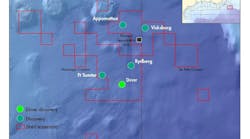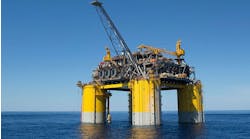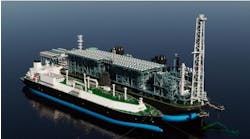In the mid-1980s, Creusot Loire, then Framatome, engineered and manufactured the Clip riser for deepwater drilling. IFP was a partner in the project responsible for the qualification and testing of the technology. Later on, Kvaerner National in Houston was appointed licensed manufacturer and marketer. Early users were Total and Elf Aquitaine, drilling in 5,000-6,000 ft of water in the French sector of the Mediterranean Sea.
Thereafter, progress was halted by the oil industry's famed downturn. The situation only improved relatively recently, following the sudden upsurge in ultra deepwater drilling. The new types of drillships and larger semis required deepwater risers suited to 18 3/4-in. BOP stacks.
Since the revival, Kvaerner National - the worldwide licensee - has sold one 21-in. Class "F" Clip riser to Foramer, designed for operations in 10,000 ft of water. This will be manufactured at the company's plant in Houston. In addition, an 18 5/8-in. Clip riser owned by Reading & Bates/Falcon is currently being repaired in Brazil. Kvaerner National also has a verbal commitment for a second Class "F" riser and four inquiries for additional Clip risers, and hopes to conclude contract negotiations later this year.
The Clip riser is distinguished mainly by its simple, break-block type connectors, suited for applications featuring high tensile loads and large bending moments. They are available in two classes - D (5,000 ft, 2,00,000 lb range) and F (10,000 ft and 2,500,000 lb). According to Benoit Debray, IFP's deputy director, drilling and production, IFP is now reactivating studies aimed at lightening the riser weight, such as application of composite materials for the kill and choke lines or for the entire riser.
Benefits of the Clip riser include:
- No threading, bolting or pre-loading, plus a high strength-to-weight ratio
- Safe hang-off during bad weather
- Proven shorter tripping time, and easy to stab, even with misalignment
- Long service life due to high fatigue resistance, and minimal maintenance due to simple design.
Correct decision at crucial stage goal of drilling program
IFP's newer initiative, called DO-IT, is aimed at fostering improvements in interactive drilling. Despite huge advances in well design, reservoir imaging, data logging, data processing and so on, it remains a problem coordinating these different disciplines so that the correct decisions are taken at crucial stages of the drilling process.DO-IT involves numerous oil and service companies and other research institutes besides IFP. Subordinate to the main objective are various technology improvement programs. Among applications targeted are early detection of abnormal situations that may arise during drilling such as drillstring vibration, wellbore instability, formation damage and fatigue failure.
Ongoing IFP projects contributing to this initiative include work on drilling fluids and seismic while drilling. The scope of the former project includes research into foam stability for underbalanced drilling, additives to reduce reservoir invasion, and analysis of the interaction betwen new types of drilling fluids and hydrocarbons.
Goals of the seismic while drilling program include recording a VSP during pipe connection in order to position the bit depth accurately on the seismic section, and improved well geometry through seismic-assisted geosteering.
One of the key tools aiding this and other interactive drilling studies is IFP's real time measurement while drilling system Trafor-X. This provides continuous wireline transmission of drilling-related data from downhole and surface sensors to process and storage computers.
Up to 15 sensors are housed on the downhole instrumented sub, while the surface sub, located under the kelly or top-drive, provides up to five drilling measurements. For comparison purposes, surface and downhole readings are synchronized.
The transmission link assembly comprises a slip ring collector, a wired kelly, several wired pipes, and at the lower end, an armored cable within the drillpipe. Total length is 143 meters. During drilling, the upper wired pipe is used to adjust the length of the link to the depth drilled. The processing system includes advanced algorithms, data analysis software and real-time graphic displays for on and off-line interpretation.
Applications on wellsites to date (which include Elf's Norwegian sector fields) range from bit motion and performance monitoring to analysis of drillstring behavior, such as bit bounce or stick-slip motions associated with torsional oscillations. Trafor-X can measure up to 400 samples per second. However, this is not a conventional MWD tool, so handling must be performed by IFP's trained team, under the drilling contractor's supervision.
Copyright 1998 Oil & Gas Journal. All Rights Reserved.


